In an increasingly competitive digital landscape, understanding where competitors are gaining traffic is a strategic matter.
A traffic gap analysis is a data-driven process that pinpoints the organic or paid traffic your competitors attract but you currently do not. It moves beyond superficial rankings and instead reveals real opportunities to refine your SEO and content strategies.
Rather than guessing which keywords to target next or relying solely on internal brainstorming, a traffic gap analysis identifies missed content opportunities and unmet audience intent.
This is crucial for business owners. It supports smarter content creation and aligns SEO with ROI.
The insights gained help close the gap between your site and industry leaders, opening doors to increased visibility, improved search share, and long-term brand growth.
Done systematically, traffic gap analysis can turn underperformance into a scalable competitive advantage.
Table of Contents
What Is Traffic Gap Analysis?
Traffic gap analysis is the process of identifying where a competitor is gaining website visitors (particularly through search engines) while your domain is absent or underperforming for the same topics.
It’s a way to uncover untapped keyword opportunities, traffic sources, and content themes that can inform your strategic roadmap.
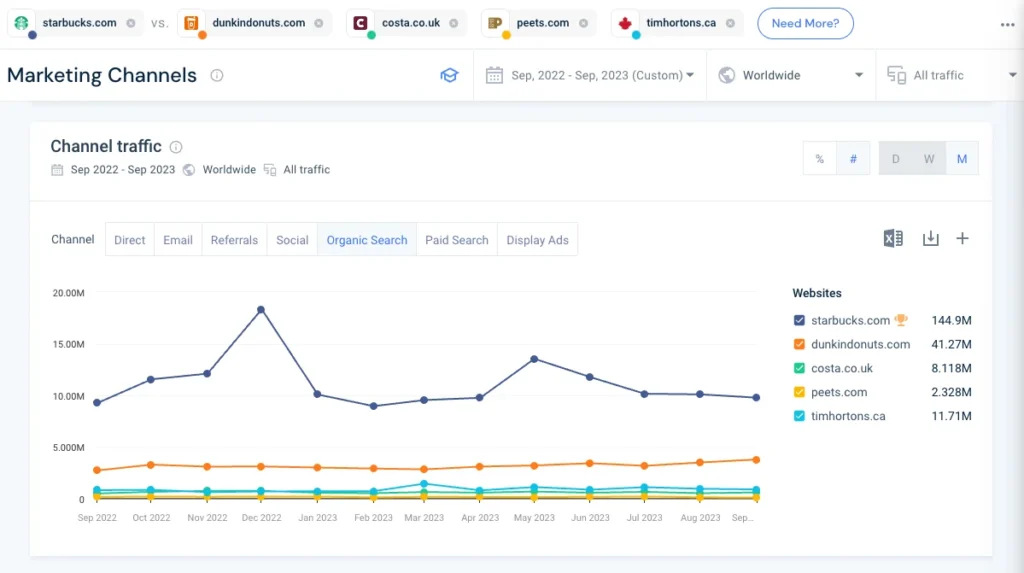
A common point of confusion is the distinction between a keyword gap analysis and a traffic gap analysis. While related, they differ in scope:
- Keyword gap analysis focuses purely on search queries that competitors rank for, but your domain doesn’t.

- Traffic gap analysis goes a step further. It evaluates actual estimated traffic from those keywords and pages, identifying which content is driving the most meaningful visits for your competitors.
Another layer of this process involves distinguishing between:
- Organic traffic gaps, which highlight missed SEO opportunities
- Paid traffic gaps, which show where competitors are investing in Google Ads or similar platforms to dominate high-value keywords
Understanding both organic and paid gaps gives a more complete view of where your brand is falling behind and where it can surge ahead.
A comprehensive traffic gap analysis supports strategic benchmarking by:
- Highlighting competitor strengths across topic clusters
- Identifying high-traffic pages or funnels that competitors are capitalizing on
- Informing content prioritization based on competitor success
- Revealing patterns in user intent, seasonal trends, or funnel-stage targeting
Ultimately, traffic gap analysis provides a measurable path to content optimization and revenue-driven SEO execution.
Why It Matters for SEO and Growth
Traffic gap analysis is more than a technical exercise—it’s a strategic mechanism that directly impacts visibility, traffic quality, and marketing efficiency. When executed properly, it transforms how SEO supports business growth.
Revealing Missed Opportunities
It’s easy to misallocate content or SEO resources without a clear picture of where your competitors are outperforming you.
Traffic gap analysis helps surface gaps in your existing strategy, whether missing topics, under-optimized landing pages, or neglected high-intent queries.
It’s especially valuable for identifying keywords that serve different funnel stages. For example, you may discover competitor content focused on informational queries that feed long-term conversions, while your content targets only bottom-funnel transactional terms.
Improving Content ROI
Once gaps are identified, it becomes easier to justify content investments. Businesses can build or update pages with proven demand rather than creating content based on assumptions. This ensures higher returns on each content asset and reduces wasteful production.
How to measure the ROI of your content efforts in 2023
Content marketing becomes predictable, measurable, and scalable by focusing on proven traffic generators.
Staying Competitive in Evolving SERPs
Search intent, algorithm changes, and industry trends can all shift rapidly. A traffic gap analysis helps track these shifts through competitor patterns. If a competitor suddenly gains significant visibility in a topic cluster, the data flags it before the impact snowballs.
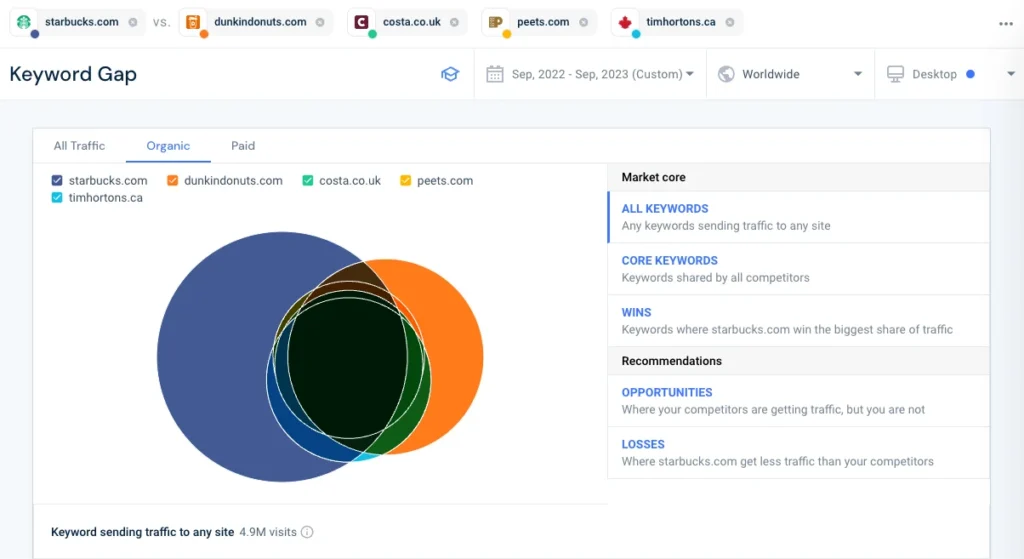
This proactive approach can allow businesses to adapt faster, protect rankings, and discover innovation spaces before saturation.
By regularly reviewing traffic gaps, businesses move from reactive to predictive SEO, capitalizing on what works, avoiding pitfalls, and capturing market share more efficiently.
Tools You’ll Need
A traffic gap analysis is only as effective as the tools supporting it. While there’s no single tool that covers every facet end-to-end, combining the right platforms provides comprehensive visibility into competitive traffic data.
- SEMrush: Offers dedicated keyword gap and traffic analytics reports. It enables side-by-side domain comparisons, estimated traffic by URL, and historical trend analysis. Strong on both organic and paid gap discovery.

- Ahrefs: Known for its robust backlink and keyword databases, Ahrefs allows domain comparisons and top content filtering by traffic estimates. The Content Gap tool pinpoints keyword opportunities that competitors rank for that your domain does not.
- SimilarWeb: Ideal for broader traffic intelligence, this tool provides macro-level insights into traffic sources, channels, and audience demographics. It’s beneficial for identifying paid traffic gaps and industry-level shifts.
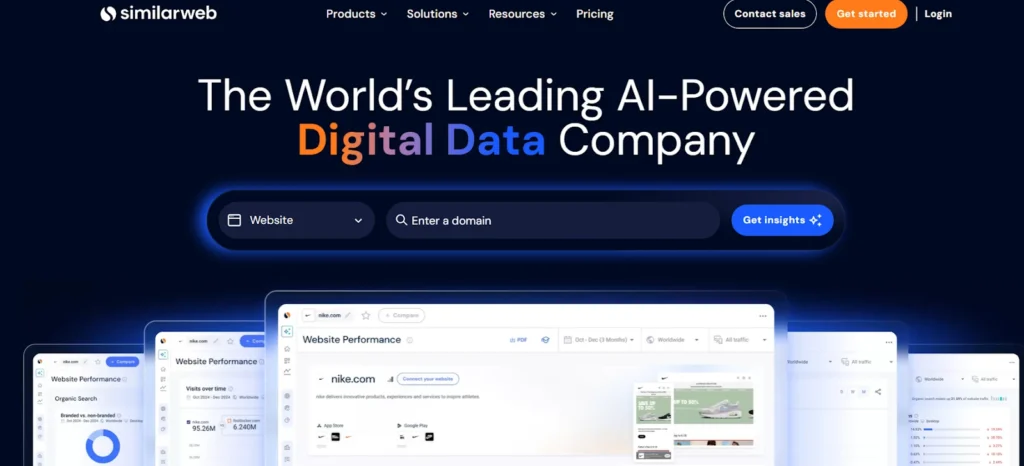
- Google Search Console + GA4: These internal data platforms won’t help directly with competitor analysis, but are essential for aligning findings with your existing traffic landscape. It identifies which discovered gaps are relevant and prioritizes based on performance.
- Screaming Frog or Sitebulb: Useful for auditing your current content and identifying potential landing pages to optimize for discovered gaps. These tools provide on-site technical SEO context that complements gap insights.
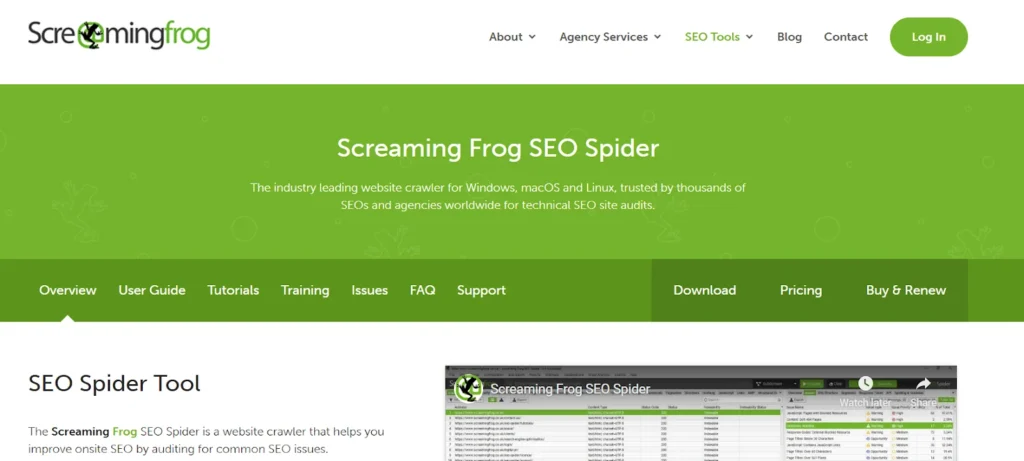
- Custom Spreadsheets or Dashboards: To interpret raw exports effectively, it’s helpful to consolidate findings, map keywords to buyer journey stages, and flag priority actions in a centralized sheet or dashboard.
With the right mix of platforms, you can execute a traffic gap analysis with precision and strategic clarity.
Step-by-Step Process for Running a Traffic Gap Analysis
Executing a traffic gap analysis requires methodical implementation to ensure both insight depth and actionability. Below is a structured six-step process that aligns with real-world marketing workflows and analytics best practices.
Step 1: Define Your Benchmark Competitors
Start by clearly identifying 3–5 competitors who closely align with your target audience, service offerings, and content categories. Avoid simply choosing the most prominent players. Focus on those actively competing in the same keyword space or funnel stages as your own site.
There are two main categories to consider:
- Direct Business Competitors: Those in your industry offering similar products or services.
- Search Competitors: Websites ranking for the exact target keywords, even if their business model differs.
Use tools like SEMrush’s Organic Competitors report or Ahrefs’ Competing Domains feature to identify who’s appearing in overlapping SERPs. Cross-reference findings with your internal keyword list to ensure strategic alignment.
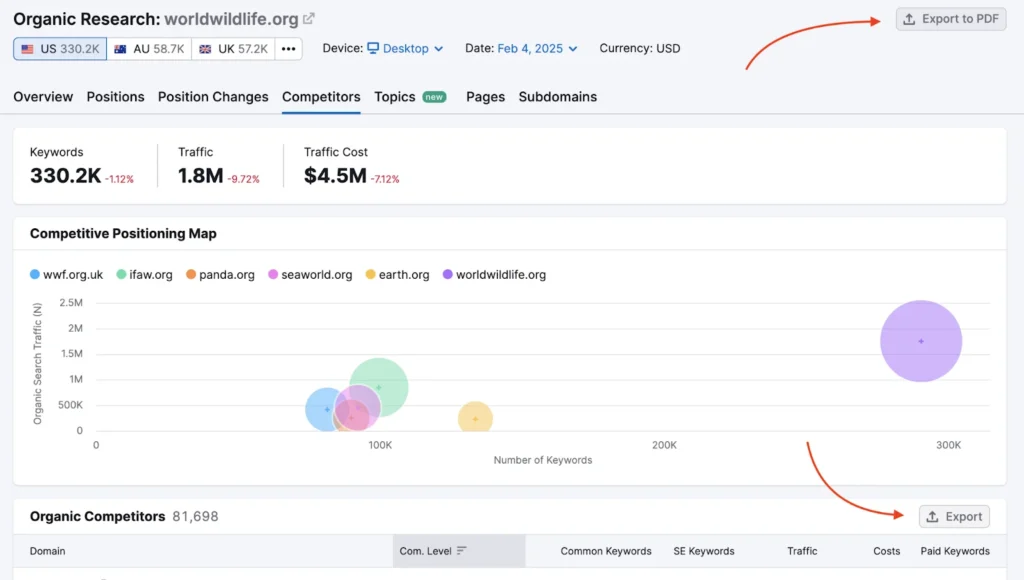
Once selected, document their domains and confirm their traffic levels are significant enough for meaningful analysis. Ensure data is fresh by checking the recency of indexed content and consistent activity.
This foundational step ensures the analysis is rooted in relevant, actionable comparisons that support content and SEO planning.
Step 2: Map Your Current Keyword and Content Assets
Before jumping into competitor analysis, take inventory of your own content’s reach and keyword footprint. This is vital for isolating true traffic gaps versus content you’ve already covered or optimized.
Use your SEO tool of choice (e.g., Ahrefs or SEMrush) to export:
- All keywords your domain ranks for in the top 100
- Traffic estimates per keyword or URL
- Keyword difficulty and intent classification
- Associated landing pages
In parallel, conduct a site crawl to gather metadata, headers, and internal linking data. If possible, segment URLs by funnel stage or content type (e.g., blog, product, service, landing page).
How to crawl your site with Screaming Frog SEO Spider (and make sense of its reports)
This internal mapping will allow you to:
- Understand existing topical coverage
- Detect underperforming or thin content
- Avoid duplicating efforts on already targeted terms
Once you’ve tagged your assets, you’ll be better positioned to compare them directly against competitors and identify areas of strategic void.
Step 3: Identify Competitor Pages Driving Traffic
Now, analyze competitor domains to isolate which of their pages are generating the most traffic. It provides tangible insight into the content formats, keyword clusters, and user intent types your business is missing.
In SEMrush or Ahrefs, use the Top Pages report to extract:
- URL-level traffic estimates
- Referring keywords
- Traffic share by URL
- Content structure (e.g., listicle, how-to, case study)
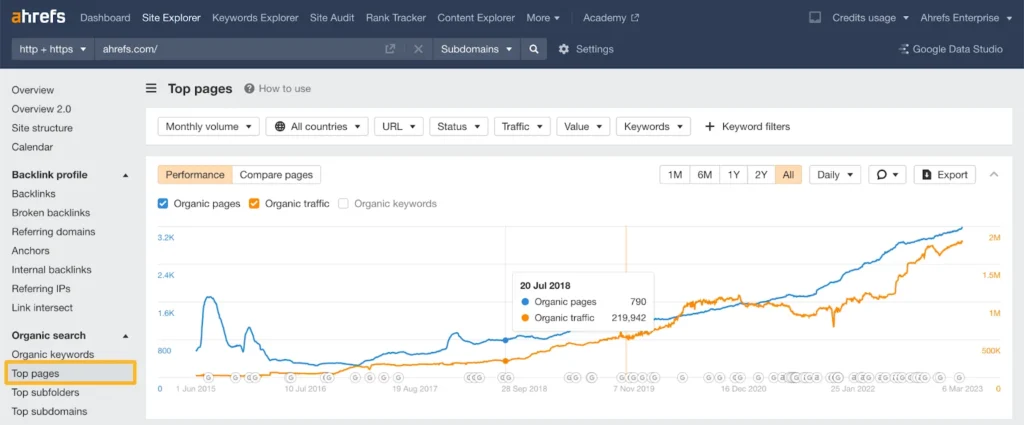
Filter pages by traffic volume and keyword overlap. Focus first on informational or commercial-intent content that closely mirrors your customer journey stages. Then, flag URLs ranking for terms where your domain is absent or appears only on page 2 or beyond.
This step begins surfacing the tactical opportunities within the traffic gap. It also hints at topic authority. Competitors may have built multiple supporting pieces around a theme, creating content clusters that enhance visibility.
By understanding what’s working for them at the page level, you can precisely begin architecting your next moves.
Step 4: Compare Keyword-Level Gaps
With the top-performing competitor pages identified, extract the keywords they rank for that your domain does not. This will highlight direct traffic opportunities currently unaddressed within your existing SEO footprint.
Use SEMrush’s Keyword Gap tool or Ahrefs’ Content Gap feature to compare your domain against competitors side-by-side. Set filters to focus on:
- Keywords where competitors rank in the top 10, but your domain is absent
- Medium to high search volume terms with attainable keyword difficulty
- Commercial or transactional intent keywords tied to buyer decision-making

Segment the gaps by intent type and funnel stage. This categorization helps differentiate between high-funnel visibility opportunities versus conversion-focused keywords.
Be cautious of irrelevant gaps. Some may not align with your services or brand. Prioritize keywords with strategic value, where content creation or optimization could reasonably close the gap and generate qualified traffic.
This phase converts raw comparison into precise keyword-level targets for content planning.
Step 5: Prioritize Based on Business Value
Not all traffic gaps are created equal. To convert insights into ROI-driven actions, evaluate keyword and page gaps based on business alignment, search intent, and potential impact.
Apply weighted scoring to each opportunity using criteria such as:
- Relevance to product or service lines
- Search intent (informational vs commercial)
- Traffic potential vs ranking feasibility
- Current customer journey fit
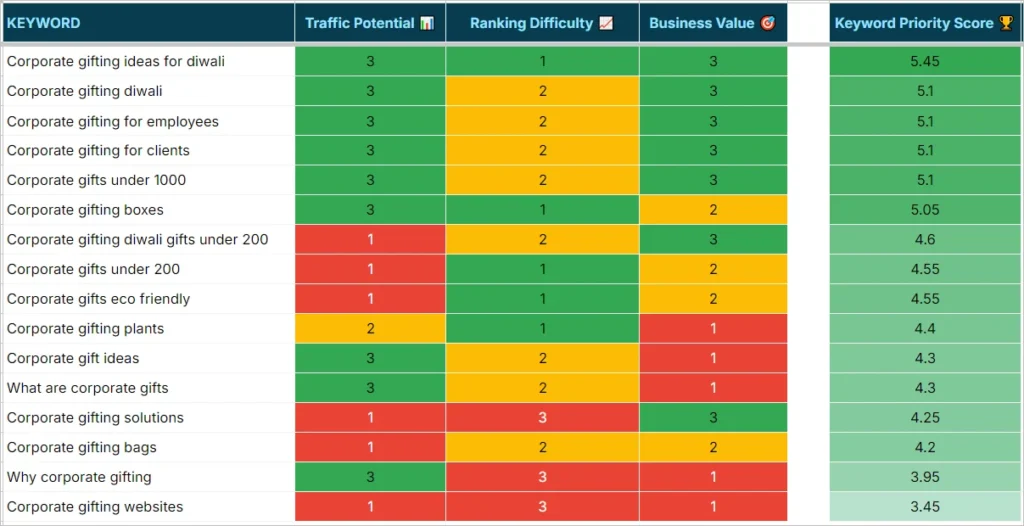
Source: Accrue SERP
Keywords with high commercial intent and clear alignment to bottom-funnel pages should take precedence. Mid-funnel opportunities tied to thought leadership or educational content may be secondary but still valuable.
Also consider technical feasibility. Some keywords may require significant content investment or structural changes to the site. Balance ease of execution with projected gain.
Develop a tiered action list, grouping opportunities into quick wins, medium-term priorities, and long-term plays. This approach ensures execution remains strategic and resource-aligned, not driven solely by search volume.
Step 6: Build or Optimize Targeted Content
Translate priority gaps into concrete content actions: either optimize existing pages or build new assets targeting missed opportunities.
For existing content, apply improvements such as:
- Updating outdated information
- Refining metadata and headers for target keywords
- Adding internal links from relevant pages
- Increasing semantic depth and aligning with search intent
For new content creation, determine the ideal format based on what’s ranking: guides, comparisons, templates, or landing pages. Use competitor pages as benchmarks while aiming to exceed them in depth, clarity, or authority signals.
Incorporate discovered keywords strategically without over-optimizing. Integrate structured data, schema, or video where applicable to improve visibility and engagement.
How To Optimize Your Content For Your Target Keyword
Ensure each piece fits into your broader content architecture and supports conversion goals. Tie gap-driven content back to product pages or lead magnets through CTAs or contextual linking.
A disciplined approach to creation and refinement ensures that traffic gap insights directly translate to measurable growth.
How to Turn Insights into Actionable Strategy
Completing a traffic gap analysis yields extensive keyword lists, competitor benchmarks, and page-level insights. To ensure this data supports long-term growth, integrate it into a structured SEO and content strategy framework.
First, map the keyword gaps into your content calendar. Assign themes or topics by month or campaign cycle, aligning with product launches, seasonal trends, or inbound funnel strategies.
Each keyword cluster should be translated into a planned asset, such as a blog post, a landing page, or feature content.
Second, consolidate findings into a gap-to-asset matrix. Match each keyword or content gap with an execution type: refresh, expand, merge, or create new. Include expected traffic gains, funnel fit, and production timelines.
This matrix can become the tactical roadmap for filling identified voids.
Third, the findings should be communicated to the broader team (designers, copywriters, developers) so that implementation aligns across roles. UX elements, technical infrastructure, and messaging should support the same user intent discovered in the gap analysis.
Fourth, ensure your measurement layer is updated. Set up dashboards or tracking tags that monitor how new or optimized content performs across KPIs like rankings, organic clicks, bounce rates, and conversions. Compare performance against initial gap projections to evaluate ROI.
Lastly, repeat the analysis quarterly. Gaps evolve as competitors shift strategies, algorithms update, and markets fluctuate. Repeating the process regularly ensures continued competitive advantage and search visibility.
By operationalizing the gap analysis, traffic insights evolve from static observations into strategic levers for growth.
Leveraging Competitive Insights Beyond Traffic Gains
Traffic gap analysis delivers valuable insights that extend beyond merely identifying keyword opportunities. One strategic advantage lies in uncovering the content strategy weaknesses of competitors.
When analyzing competitors’ top-performing pages, patterns emerge—whether in content formats, frequency of updates, or depth of topic coverage.
Businesses can develop differentiated content strategies tailored to audience preferences by understanding these nuances.
For instance, if competitors rely heavily on listicles but lack comprehensive guides, your content can fill this void, positioning your brand as a more authoritative resource.
Additionally, traffic gap data can inform link-building campaigns. Pages that drive significant traffic for competitors often have firm backlink profiles.
Mapping these backlinks reveals potential outreach targets and partnership opportunities, directly impacting your domain authority and rankings.
Moreover, the analysis supports UX and site architecture optimization. Traffic gaps often highlight missed opportunities where competitors have streamlined user journeys or integrated rich media elements that improve engagement.
Aligning your site’s structure and experience with these insights can reduce bounce rates and increase session duration.
Finally, the insights help refine paid media and remarketing efforts. Keywords identified in the traffic gap can inform PPC campaigns or retargeting strategies, bridging organic and paid channels for holistic growth.
In summary, traffic gap analysis is a comprehensive competitive intelligence asset that can enhance multiple facets of digital marketing and business growth.
Common Mistakes to Avoid
Applying traffic gap analysis effectively requires avoiding several critical pitfalls that can undermine results:
- Focusing Solely on High-Volume Keywords: Prioritizing only search volume ignores intent and business relevance, resulting in wasted effort on traffic that doesn’t convert.
- Ignoring Content Quality and User Experience: Filling gaps with low-quality or poorly structured content can damage brand credibility and increase bounce rates.
- Overlooking Competitor Context: Not considering why competitors rank for certain keywords (e.g., geographic focus, brand strength) can lead to unrealistic expectations.
- Failing to Align with Overall Strategy: Traffic gap insights must integrate with broader marketing and sales objectives. Disjointed execution leads to fragmented outcomes.
- Neglecting Ongoing Monitoring: Markets and search algorithms evolve. Conducting a one-time gap analysis without periodic review limits long-term benefits.
- Underestimating Resource Requirements: Gap closing often requires cross-functional collaboration and budget allocation. Without realistic planning, execution stalls.
- Misinterpreting Data Due to Tool Limitations: Relying exclusively on one tool’s data without cross-validation risks incomplete or inaccurate conclusions.
By anticipating and addressing these common mistakes, businesses can maximize the strategic value of their traffic gap analyses and improve execution efficacy.
Conclusion
A traffic gap analysis is a powerful method for uncovering hidden opportunities within competitive landscapes. When executed thoughtfully, it provides actionable insights that extend beyond SEO, influencing content strategy, link building, UX, and paid campaigns.
However, success depends on strategic prioritization, rigorous alignment with business goals, and continuous monitoring. Avoiding common pitfalls ensures traffic gap findings translate into sustainable growth and enhanced market positioning.
Business owners who leverage this methodology systematically gain a sharper competitive edge and a clearer path to capturing valuable organic traffic in dynamic digital ecosystems.


